The Combination of Images and Text on early playing cards
When playing cards have titles or legends these reference a written/literary tradition of some form. It connects the image to a wider cultural sphere, extending the visual impact.
The Medium is the Message
Many early playing cards had titles or legends alongside the images. These referenced a written/literary tradition of some form (historical, religious or secular literature, legends, etc), connecting the image to a wider cultural sphere, extending the visual impact. For example, French court cards were given names of heroes of antiquity, such as Caesar, Charlemagne, Paris or Lancelot, thereby connecting to the written body of French literature. This tradition goes back to the fifteenth century or even earlier. Some historians believe that court cards are actually based on these historical personages, but this is not necessarily true.
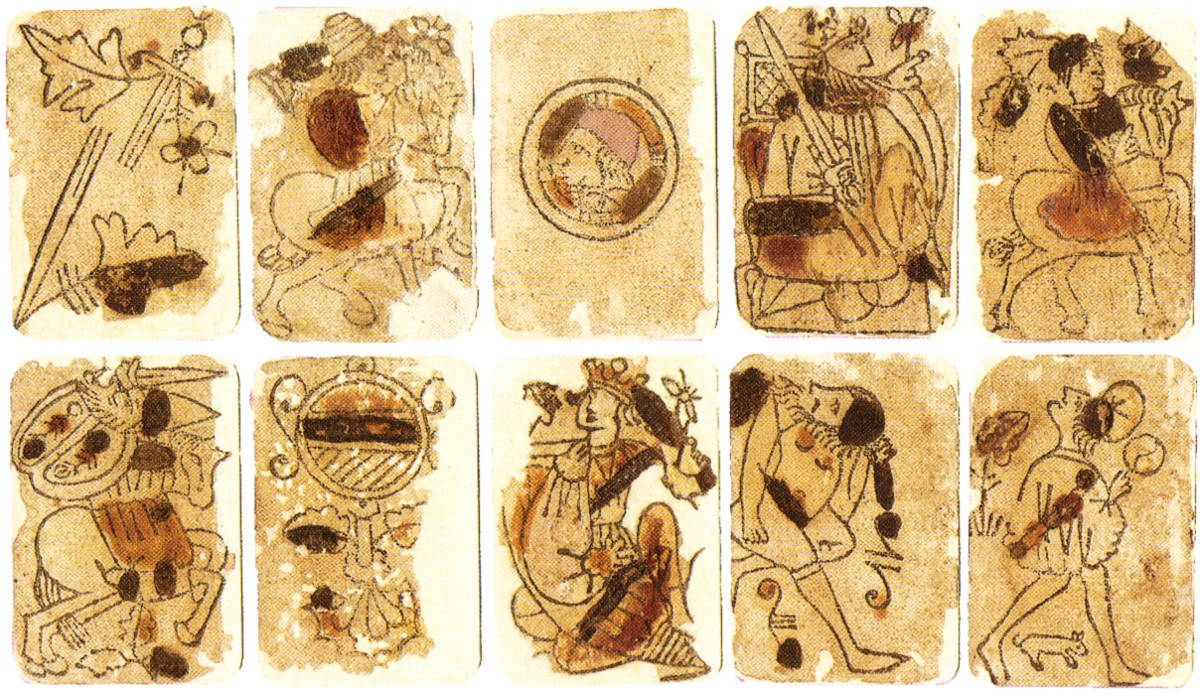
Above: cards from a primitive Latin suited pack, dated by paper analysis as “early XV century”. The cards are untitled, without any legends.

Above: four French cards designed by Jean Personne, c.1495. The cards carry inscriptions such as "Paris", "Melusine", "Conte de Chalou" and the maker's name, "Jhan Personne".
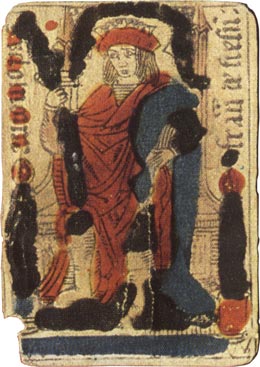
Above: early XVI century Spanish-suited card with inscriptions
But many early cards were unnamed and unnumbered, so they were understood by card players on their own terms. If the cards are just images, with no title or legend, then the images must speak for themselves. There is no explicit reference to any text, or suggestion that the cards are based on historical persons.
The advent of printing with movable type boosted the spread of literacy and the playing card was also used as a medium to propagate the printed word.
Thus the presence of printed text or titles on playing cards adds a new level of meaning and raises their cultural status to a more rational, literate or pedagogic level; a vehicle for political or educational purposes (as well as a game of luck and skill). Today of course this might be an advertising message.

The early Arabic Mamluk cards incorporated calligraphic texts, rhyming aphorisms, evoking thoughts of a religious nature, on the court cards (inside the blue areas). But because of Islamic law, instead of images of human figures we see only abstract geometric designs on the rest of the cards. The written words transform these into sublime messengers.
“As for the present that rejoices, thy heart will soon open up“ - “I will, as pearls on a string, be lifted in the hands of kings” - “May God give thee prosperity; then thou will already have achieved thy aim” - “Rejoice for thy lasting happiness” - “Rejoice in the pleasant things and the success of the objects” - “I am as a flower, a string of pearls is my soil?” - “The alif rejoices and fulfils your wishes” - “Whosoever will call me to his happiness, he will only see joyful looks”.
These Arabic playing cards are believed to be the progenitors of playing cards in the West more →
In the case of tarot trumps the early examples are unnamed and unnumbered. Again, they were implicitly understood or memorised by the players. In some instances initial letters or monograms were added to denote a secret meaning which is often lost.
Legends and numbers were added later to tarot trumps to denote their value or hierarchy so that a canon was established which today we take for granted. Some people believe the tarot cards are a channel for esoteric thought. There were exceptions to this: Animal Tarots and other games with non-standard trump cards did not usually have titles or metaphysical associations.
The phonetic alphabet is a unique technology which, through its uniform and sequential logic, has created civilized man, with codes of law, ledgers and ultimately, printed books. In a humble way, playing cards have participated in this development by becoming a medium for the message....

Above: detail from the Cary Collection uncut and uncoloured sheet of tarot cards (housed in the Beinecke Rare Book and Manuscript Library, Yale University in New Haven, Connecticut) probably printed in Milan and possibly dating as early as c.1500. The images are untitled and unnumbered, suggesting that players must have already known the sequence or hierarchy of trump cards in play from contemporary knowledge.
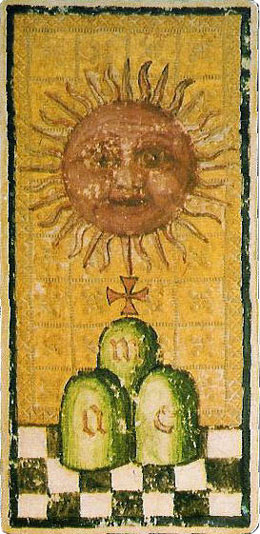
Above: the 'Sun' from the Goldschmidt tarot. The three initial letters in gothic script imply an association with a certain teaching or literary text which may have been available only to initiates, but which is now unknown. Thus a whole new level of meaning could be attributed to a simple playing card by means of a few letters.
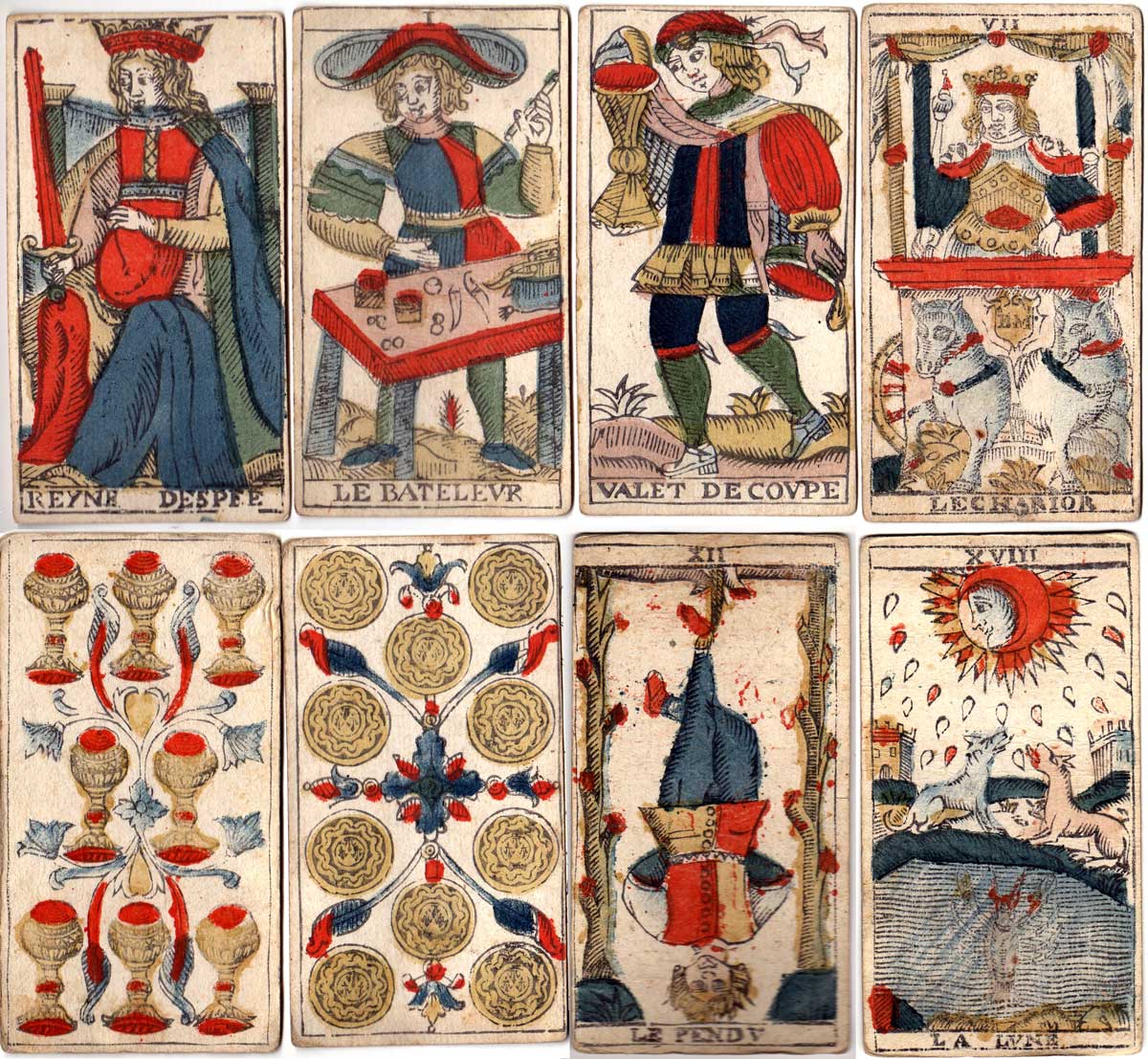
Above: Tarot de Marseille by Jean-Baptiste Madenié, Dijon, early 18th century. The trump cards are named and numbered to designate their value during play. Images courtesy Frederic C. Detwiller.
By Simon Wintle
Spain • Member since February 01, 1996 • Contact
I am the founder of The World of Playing Cards (est. 1996), a website dedicated to the history, artistry and cultural significance of playing cards and tarot. Over the years I have researched various areas of the subject, acquired and traded collections and contributed as a committee member of the IPCS and graphics editor of The Playing-Card journal. Having lived in Chile, England, Wales, and now Spain, these experiences have shaped my work and passion for playing cards. Amongst my achievements is producing a limited-edition replica of a 17th-century English pack using woodblocks and stencils—a labour of love. Today, the World of Playing Cards is a global collaborative project, with my son Adam serving as the technical driving force behind its development. His innovative efforts have helped shape the site into the thriving hub it is today. You are warmly invited to become a contributor and share your enthusiasm.

Related Articles

Early German playing cards
Some early examples of popular German playing cards from the XV and XVI centuries.

Pierre Roiné Aluette
Archaic form of Aluette published by Pierre Roiné, Nantes, c.1785.
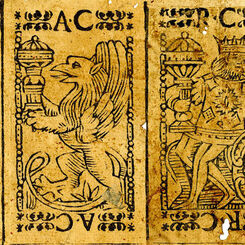
Portuguese-suited cards
Portuguese-suited cards with dragon aces, made in Italy, 1613.
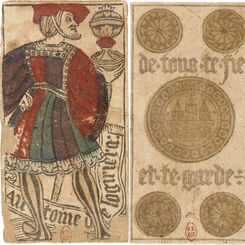
Antoine de Logiriera
Archaic Spanish-suited playing cards published in Toulouse by Antoine de Logiriera (1495-1518).
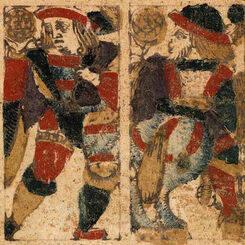
Toledo, 1584
Archaic Spanish-suited deck with 48 cards made in Toledo in 1584.

Iohann Christoph Hes Tarot c.1750
Facsimile of Tarot de Marseille by Iohann Christoph Hes, Augsburg, c.1750.

Navarra Pattern, 1682
Navarra pattern produced for the Pamplona General Hospital Monopoly in 1682.
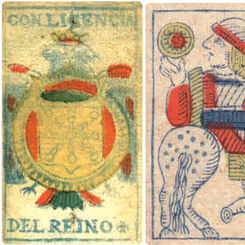
Navarra Pattern
Navarra Pattern produced for the Pamplona General Hospital Monopoly.

XV Century Catalan playing cards
XV Century Catalan Playing Cards, featuring four female Sotas, four Aces and four cards from the sui...

Malta
The so-called ‘Dragon Cards’, with winged monsters on the four Aces, are an enigmatic aspect of earl...
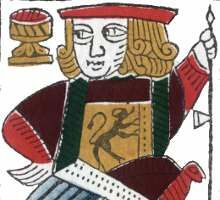
Navarra, XVII Century
Facsimile of 17th century Spanish-suited playing cards produced by Erregeak, Sormen S.A., Vitoria-Ga...
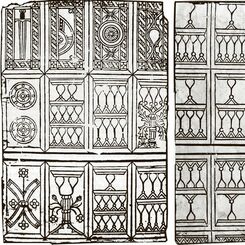
Moorish playing cards
These two uncoloured, uncut sheets of early Moorish playing cards were formerly preserved in the Ins...

Gothic Spanish-suited cards
These cards may be a typical example of early 'standard' Spanish playing cards, maybe from before Co...

Early Anglo-French Cards
Cards produced in Rouen during the sixteenth century. It was cards like these which were imported to...

Mamluk Playing Cards
Nã'ib, the game of lieutenants... these cards are amongst the earliest Arabic playing cards ext...

Early History of Playing Cards & Timeline
Out of an apparent void, a constellation of references in early literature emerge pointing to the su...

Baraja Morisca — Early XV century playing cards
Primitive Latin suited pack, dated by paper analysis as early XV century, which makes this one of th...
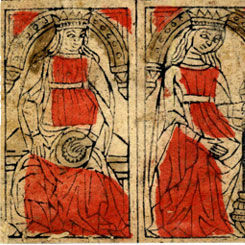
XV Century Italian Playing Cards
Cards from a pack of an early form of north Italian playing cards, with the swords back-to-back and ...

Early Spanish/Portuguese type
Fragment of a sheet of archaic Spanish-suited 'Dragon' playing cards found during restoration of a h...
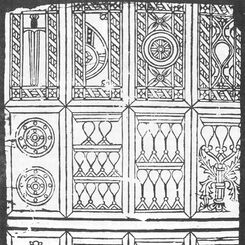
A Moorish Sheet of Playing Cards
This article was originally published in “The Playing-Card”, the Journal of the International Playin...
Most Popular
Our top articles from the past 60 days






















